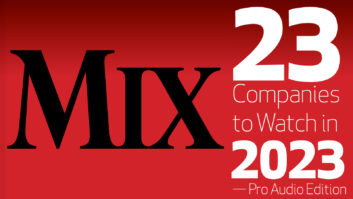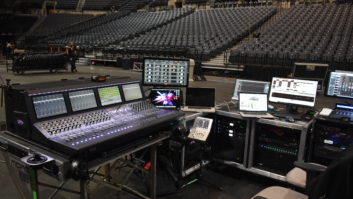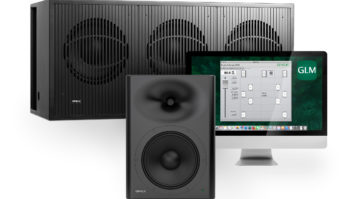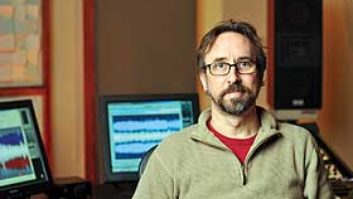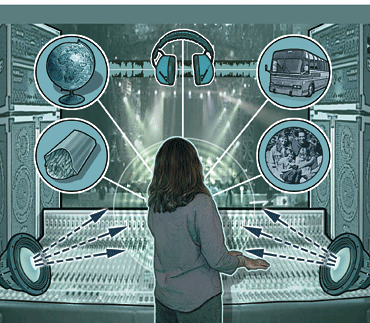

You get the call: “Hey, can you mix for so and so from May to August?” It’s a fight to keep busy — especially with a shortened touring season and more live sound engineers entering the field — so you take the gig. You’re familiar with the artist and you know the tour is going to be hectic. And it doesn’t take a rocket scientist to figure out it’s going to be loud.
But this is the risk front-of-house engineers take when accepting work — knowing that after a four-month tour, where the band performs five nights out of the week for two hours a night, their ears (and maybe even their well-being) may suffer some serious damage.
Illustration: Tad Majewski
It takes a certain mind-set to endure this lifestyle, one in which not only are engineers’ ears constantly being beaten up, but it’s also a struggle to maintain their mental health despite the rigors of the road. What are engineers doing to ensure that their ears stay just as healthy as they were before the P.A. was turned on, as well as keep their sanity long after the “venue-to-bus, bus-to-venue” routine gets old? Fortunately, they’re doing a lot.
TO CHECK, OR NOT TO CHECK?
As in all aspects of the audio industry, there is increasing awareness among live sound pros about their hearing health. Hearing loss may still be a taboo subject for discussion, but these road warriors are conscious of maintaining good hearing and, for the most part, are getting their ears checked. After all, hearing damage is cumulative and awareness is the first step toward ensuring a long professional life.
Longtime sound reinforcement engineer Robert Scovill (Tom Petty & The Heartbreakers, Prince, Def Leppard, Rush, Matchbox 20) began making changes after speaking with an audiologist about “the wicked ways of the concert world.” He began reducing his overall average exposure to SPL during his daily routine. This involved finding a place with “absolute quiet” where his ears could rest the same amount of time as the event, reducing exposure to the high SPLs on average. “On a nightly basis after the show, I would try to avoid loud music or TV on the bus or avoid going to nightclubs,” he explains. “I would put in high-reduction ear plugs as soon as I could after the show, especially during sleep hours while the bus was traveling to shake off the show and the roar of the bus engines.”
Also to be found hiding out in the bus post-show is Chris Rabold (Widespread Panic); after a three-hour gig, he’ll rest his ears while reading a good book. His ears have taken abuse with the band’s rigorous tour schedule, which can comprise five shows a week, up to 8-week tours and assorted one-offs. Coupled with that, he’s running the show around 103 dB. “I feel that once you get below 100dB SPL, a much more ‘comfortable level,’ it feels like there is a show going on and your eyes are drawn to the stage and you feel like you’re watching a show,” he explains. “Once you get above that, you’re feeling it more, it’s right up in your face and you get that feeling of ‘the band is putting it out and I’m feeling it and we’re all in this together.’
“And that, to me, is where excitement is created,” Rabold continues, “so I like to cruise around 103, which is not terribly loud, but there are peaks in there — 109 easy — and after that is sustained for three hours, I anticipate and accept the fact that, by the end of the night, my ears are going to be beaten up. The world is definitely more bothersome after the show’s over; you’re so much more aware, you’re tempted to steer away from loud noises. It’s definitely something I’m mindful of, but it’s that trade-off between job hazard and job passion.”
There are job hazards aplenty to be found on a tour. You may be fixing mic placements just when the drum tech decides it’s time for line check or, as Brad Madix (Shakira, Rush, Def Leppard, Marilyn Manson) explains, “I managed to find myself re-seating a connector under the stage behind a monitor desk just as a concussion grenade went off. They used to put them under there with cases behind them to direct the ‘blast’ out from underneath the stage. I learned early on that if you’re not doing critical listening, you should always wear ear protection.”

Bryan Cross
Also carrying earplugs are Bryan Cross (Tower of Power, Vertical Horizon, Lifehouse, Howie Day), who also regularly checks his hearing, and Pete Keppler (Nine Inch Nails, David Bowie, AFI), who purchased custom-molded plugs with filters for different levels of attenuation — and wears them! Keppler says some instances that he can recall that have contributed to hearing damage come as a result of working onstage without protection, “especially miking up drums and guitars,” he says. “Right when your head’s next to the drum kit or the 4×12 cabinet, some idiot decides it’s time to play. If I know I’m going to be in potentially loud environments, I always keep my plugs handy.”
On the flip side, Dave Natale (Tina Turner, Joe Cocker, Lionel Richie, Mötley Crüe), chooses not to get his hearing checked, relying mostly on feedback about his mixing style. “People aren’t complaining that I mix really loud, which means I don’t think my hearing has taken a serious beating,” he says.
However, he is concerned about the subconscious effects that the results of these hearing tests would have on his ability to mix a show. “If you get your hearing tested,” he continues, “and they show you a graph and you have a big hole at 3 or 4k, when you’re standing out there mixing after that, you’re going to think, ‘Now I wonder if there’s too much 4k because I know that I can’t hear it.’ You’re going to start over- or under-compensating and second-guessing yourself.”
But Natale does take steps to ensure his hearing health, including wearing earplugs at a gig when he’s not mixing, not listening to the support band and mixing dynamically. For example, on his recent jaunt with the Rolling Stones, “They would play some up-tempo stuff and that’s just loud the first few songs because you need to get over the excitement of the crowd, and then toward the end, the last three or four songs, you get really loud because it’s supposed to be a climax in the show. So I try and not mix everything at the same level. I’ve been to a bunch of shows where guys turn stuff up and then they never turn it down again.”
MAKE MINE DIRECTIONAL
Recent advances in P.A. technology have given FOH engineers increased control over consistency of volume throughout the venue, as well as the perceived loudness of a show. However, engineers need to understand the physics of a P.A. — the proper setup, tuning, power distribution, etc. Keppler points to the fact that a clean, undistorted P.A. can seem deceptively quiet. “If you start to push too much volume, you’ll really pay for it by the end of the night,” he says.
Rabold notes that with today’s P.A.s, an FOH engineer can tailor the sound very specifically so that the mix can still be loud but not harsh and bothersome by steering clear of the midrange. “That 1.6 to 3k [can be] really hurtful stuff,” he says. “So if you can tailor the P.A. that way, you can go longer periods of time without it being an ‘oh my god ice pick in the ear’ kind of thing. With line arrays, where you’re maintaining equal and constant SPL at varying distances, it’s easy to know that it’s 102 at 25 feet from the downstage edge, it’s 102 at the second level of the balcony, et cetera. It’s a lot easier now to have a consistent SPL around the venue. We can’t value that enough because it really puts us in control of what’s going on. There’s always going to be the problem of a venue where you have to stack the P.A., which is where you’re going to have an audience member with a speaker right in their face — literally. We’re always going to have low trim heights where P.A.s don’t fly that high, and that’s the logistics and reality of the live touring realm.”
Rabold points out a very real situation: Yes, you may be able to have even coverage throughout a large concert venue, but what about that one club where you can’t fly the system? What about that audience member who got to the venue hours before show time so that he could get a spot right in front — and right in front of a speaker? “To whatever degree reasonable,” Madix advises, “engineers need to take the time to make the SPL even around all of the seats. It hardly matters to the guy pressed against the barricade that it’s 94 dBA at the mix position if it’s 120 dBA where he is. Of course, in the real world — where SPL diminishes over distance and sometimes P.A.s have to be stacked — you can only do what you can do. Sometimes the guy in front is going to be exposed to higher SPL than the guy just to the left of the mix or in the back of the room.
“A problem arises when shows are very long, though,” he continues. “If management is pressuring you to make the mix 101 dBA and the show is two hours long, there’s no way to appropriately limit the exposure time for the audience. On the other hand, it’s just not reasonable to mix a rock show at 89 dBA. Of course, I can — and do — wear earplugs during long shows, but the audience is left to their own devices. The best thing to do is provide ear protection for audience members and put signs informing them of the risks and let them choose whether or not to avail themselves of it.”

Brad Madix
And that’s exactly what Cross has done with the Pussycat Dolls tour: He pulls aside his barricade security during a meeting and says, “Here’s a box of earplugs for you. If you see little kids out there, at least offer it to them.” That may be one more thing to put down on the rider, and with shrinking budgets, that just may be too costly, but as Cross points out, “A box of earplugs per week costs you, what, $35?”
FOH engineers aim for volume management that is ideal for the style of music and crowd comfort. “If you study your audience,” Scovill continues, “you can get a pretty good sense of whether it’s too loud or even too quiet. Too loud and they tend to look like ‘a deer in the headlights’ and their activity and response to the music generally declines as they just drift into a mode where they appear to be just tolerating the presentation. I saw an extreme example of this: I remember watching a colleague of mine mix at a very ‘heavy’ show that had a considerable mosh pit in action. He could literally control the intensity of the activity in the mosh pit with the volume fader.”
A recent trend these engineers point to is that the FOH compound has ever-so-slowly been moving farther and farther back, making “listening” to the P.A. to ensure an appropriate level an even more difficult task. “First of all,” Natale says, “you’re going to mix it a little louder because you have to hear it. I like to have a certain amount of pressure when you’re mixing with the kick drum — stuff like that. I also like to feel like I’m in the same venue with the band, like I’m part of the show. But there seems to be this trend of putting the FOH position too far away. People mix basically indoors anywhere between 90 and 120 feet. Outdoors, you mix anywhere from 120 to 140 feet and people are being pushed way farther than that.”
Scovill agrees: “What I feel always needs to be addressed is for venues to provide for a mix position that allows the mixer to make relevant tone and balance decisions for a given audience geometry. It can’t be a mix position that takes up the least amount of seats or is the most ‘out of the way.’ This is for the guy making tone and balance decisions for the entire room! You can’t just shove him over there in the corner or in the back of the arena, or even in a horribly treated sound booth where he will have a perspective unlike any other listener in the room.”
If you can’t hear the P.A. well enough, how can you be expected to put on a great-sounding show? “There is stress now because as high as the ticket prices are these days, if you sit and think, ‘Two-hundred dollars a ticket times 50,000 people,’ that’s $10 million,” Natale says. “If the P.A. goes out, I’m liable for $10 million. Once, you might be able to fast-talk your way out of that; twice, not a chance.” It may sound a bit far-fetched to think that an engineer could be liable for such a large chunk of change, but this could be a very real stress for many engineers — just thinking about all of the gear they are required to “control” to create the best-sounding show they are hired to do. “A P.A. is complicated and there’s a lot of stuff [on a tour]: three, four monitor consoles; two FOH consoles; hundreds of thousands of lines going everywhere; 300-foot lines going out front; things are moving, things can get run over; power cables can get pulled out — there’s stress thinking about that,” Natale adds.

Pete Keppler
Photo: Steve Jennings
NO YOGA ON THE BUS
You’ve been on the venue floor since 9 a.m. and you don’t get back to the bus until well after midnight — after everything’s been torn down and loaded on a truck. You get to do that all again in another city, and another, for the next four nights, with perhaps a few days off after that — if you’re lucky. Multiply that week schedule for a four-month tour, and you’ve got a basic sense of what it means to be “on the road.” Throw in the fact that with reduced budgets, more engineers are getting tagged with production management duties (sometimes FOH engineers even add monitor engineering), less crew and more work within the same 24-hour day, and it’s amazing that you don’t hear more stories about engineers just “losing it.” But as we said earlier, it takes a very unique character to thrive on road life, stress and all.
“Right now I’m sitting in my office and I’m looking at a bunch of rigging plots and lighting plots and advance stuff; there’s very little audio in front of me,” Rabold says. “I do the production side of things, as well — I have never really known it any other way. If you’re doing production and front of house, there’s really no time off; you might be able to ignore your phone for a few hours on a day off, but, ultimately, you’re going to have to get up and deal.”
Cross also wears numerous hats, finding that his stress level is up there for the first couple of weeks before he can ease into a daily routine. “If the advance work is done properly, your stress level doesn’t have to be as high. It’s stressful, though: When it rains, it does pour. Prioritize your problems, step back and figure out what absolutely has to get done to make the show happen and then attack those problems one at a time.” Ensuring even more road-sanity, Cross advises any audio crew to get out and do something fun on an off-day. For a recent tour, Cross and crew would scope out the nearest indoor go-cart track and tear it up.

Dave Natale
Keppler found that learning how to properly approach tour and production managers with certain problems was a big step for him. “Practicing acceptance of situations that were beyond my control was another,” he adds. “I leave the really long hours for the lighting crew. I run and use hotel gyms for exercise, and that can melt away stress and resentments. Bad tour bus drivers have been a major stress factor for me on occasion, and I won’t think twice about having a bad driver replaced — that person has your life in their hands. If it were really getting that stressful, I would start looking for other work.”
For some, being both on the production side and the audio side can be quite fulfilling — and a stress-reliever! Lately, Natale has been a mixer foremost, but has added crew chief or systems engineer titles along the way. “I live at the gig,” he says. “I go in at 8 in the morning and leave after load-out. I walk around and look at everything all day so that when a show goes on, all I have to think about is mixing. That’s how I reduce my stress. I also insist on guys that are absolute top-shelf.”
“If you’ve got good guys around you,” Rabold agrees, “your stress level is reduced greatly because if you try to go out there and micro-manage things, you’re just asking for it because the scope of this stuff is just too large to not have good people around you and trust in what they are doing. On a day off, I’ll try and make myself take some time off — try to acclimate to the real world for a day. If you go to a pet store and see those balls where you can put a hamster in and they roll around, that’s kind of what touring is like: You can see the outside world, but you’re not really in it. It’s right there, you can see it, but you’re not really part of it.”
Sarah Benzuly is Mix’s managing editor.
Back to the Real World
Sometimes, you just have to get away from it all. Here’s where you can find these travelers when the passport has been filled up:

Robert Scovill
Photo: Gabe Echeverria
Robert Scovill
I try to do anything or go anywhere where I am not exposed to technology or media in any way shape or form. I love to get out and do things that have little or nothing to do with the music business and require very little technology as we know it.
Bryan Cross
When I get home, it’s been sports cars as my latest hobby. You can actually get in them and drive them the way they’re supposed to be driven.
Brad Madix

Chris Rabold
Photo: Sheldon Radford
I like to spend time with my family. We have a little place up in the mountains where the cell phone doesn’t work and we try to get away there whenever we can.
Pete Keppler
I really love spending time with my kids. Other than that, I go to the beach as often as I can, go hiking, eat really well, continue with yoga and meditation.
Chris Rabold
I like to spend time with my wife and our dogs — doing whatever it is they want.
Dave Natale
I putz around in my studio. If there’s an interesting band that doesn’t have any money, I’ll do that. But mostly I do tech stuff in my studio and work around the house. There’s absolutely zero life on the road, so I do as much as I can when I get home.

More tips and war stories from these front-of-house engineers here.
